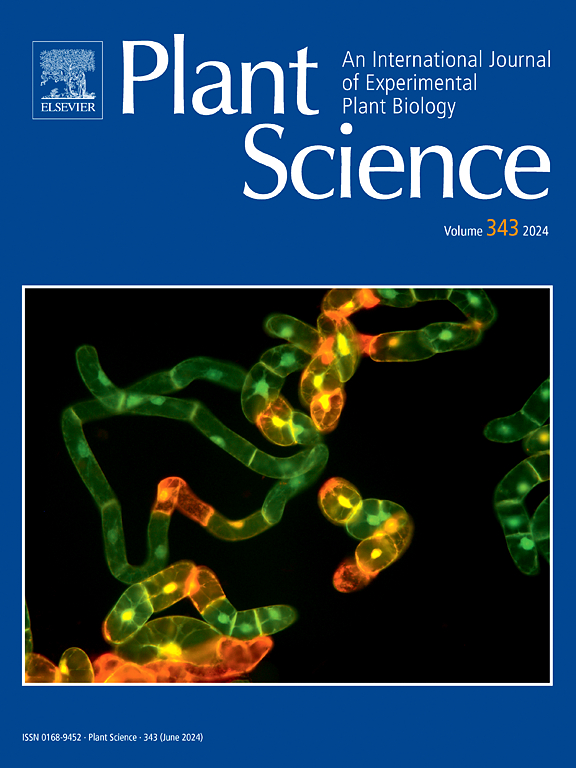激酶结构域多样化驱动BRI1和非BRI1 RLKs在油菜素内酯信号传导中的特异性
IF 4.2
2区 生物学
Q2 BIOCHEMISTRY & MOLECULAR BIOLOGY
引用次数: 0
摘要
受体样激酶(receptor -样kinase, RLKs)是真核蛋白激酶(Eukaryotic protein kinase, EPKs)中最大的家族之一,是通过植物的重复复制和多样化事件进化而来的。RLKs调控植物生长发育的多种作用。油菜素内酯不敏感基因1 (BRI1)及其家族成员BRI1- like 1 (BRL1/3)、BRL2、过量小孢子细胞1 (EMS1)和线虫诱导的LRR-RLK 1 (NILR1)属于rlk家族,通过保守的油菜素内酯(BR)信号通路控制不同的生物学功能。我们之前证明BRI1和GASSHO1 (GSO1)之间的激酶特异性仅受两个亚结构域的变构调节,这提出了不同的RLKs如何通过其保守的激酶结构域(KD)控制不同的生物学功能的问题。在这里,我们通过将BRI1的细胞外结构域(ECD)与BRI1家族的KD和非BRI1家族的RLKs,包括bak1 -相互作用受体样激酶1 (BIR1)、BIR2、TOAD2 (RPK2)、几乎任何分生系统(BAM1)、CLAVATA 1 (CLV1)、SOBIR1、延伸因子(EF-Tu)受体(EFR)、聚糖感知4 (IGP4)和strubbelig1受体家族8 (SRF8)融合来设计嵌合受体,并证实只有BRI1家族实现了BR信号输出,而其他家族没有。然后,我们用BRI1激酶相应的S1和S2亚结构域替换了嵌合受体的S1和S2亚结构域,发现除了GSO1BRI1-S1S2外,没有其他嵌合受体在BRI1- 301突变体中诱导BR信号传导。然而,嵌合受体RPK2BRI1-S1(E)S2、EFRBRI1-S1(E)S2、IGP4BRI1-S1(E)S2、BAM1BRI1-S1(E)S2和SRF8BRI1-S1(E)S2与BRI1扩展的S1子结构域S1(E)不仅挽救了BRI1- 301,而且实现了分子表型。总之,本研究提供了证据,表明RLKs的信号特异性是通过S1和S2子结构域的进化而进化的。本文章由计算机程序翻译,如有差异,请以英文原文为准。
Kinase domain diversification drives specificity in BRI1 and non-BRI1 RLKs in brassinosteroid signaling
Receptor-like kinases (RLKs) are one of the largest families of Eukaryotic protein kinases (EPKs) that evolved through repeated duplication and diversification events in plants. RLKs regulate diverse roles of plant growth and development. Brassinosteroid Insensitive 1 (BRI1) and its family members BRI1-Like 1 (BRL1/3), BRL2, Excess Microsporocytes 1 (EMS1), and Nematode-Induced LRR-RLK 1 (NILR1) that belong to the LRR-RLK family of RLKs, control distinct biological functions through a conserved brassinosteroid (BR) signaling pathway. We previously demonstrated that the kinase specificity between BRI1 and GASSHO1 (GSO1) is allosterically regulated by merely two subdomains, raising a question of how different RLKs control distinct biological functions through their conserved kinase domain (KD). Here, we engineered chimeric receptors by fusing the extracellular domain (ECD) of BRI1 with KD of the BRI1 family and with non-BRI1 family RLKs, including BAK1-Interacting Receptor-like Kinase 1 (BIR1), BIR2, TOAD2 (RPK2), Barely Any Meristem (BAM1), CLAVATA 1 (CLV1), SOBIR1, Elongation Factor (EF-Tu) Receptor (EFR), Glycan Perception 4 (IGP4), and Strubbelig-Receptor Family 8 (SRF8), and confirmed that only the BRI1 family achieved BR signal output but not the others. We then replaced the S1 and S2 subdomains of the chimeric receptors with the corresponding S1 and S2 subdomains of the BRI1 kinase and found that except GSO1BRI1-S1S2, no other chimeric receptor could induce BR signaling in bri1–301 mutants. However, chimeric receptors RPK2BRI1-S1(E)S2, EFRBRI1-S1(E)S2, IGP4BRI1-S1(E)S2, BAM1BRI1-S1(E)S2, and SRF8BRI1-S1(E)S2 with an extended S1 subdomain S1(E) of BRI1 not only rescued bri1–301, but also achieved molecular phenotypes. In conclusion, this study provides evidence that signaling specificity of the RLKs has evolved through evolution of the S1 and S2 subdomains.
求助全文
通过发布文献求助,成功后即可免费获取论文全文。
去求助
来源期刊

Plant Science
生物-生化与分子生物学
CiteScore
9.10
自引率
1.90%
发文量
322
审稿时长
33 days
期刊介绍:
Plant Science will publish in the minimum of time, research manuscripts as well as commissioned reviews and commentaries recommended by its referees in all areas of experimental plant biology with emphasis in the broad areas of genomics, proteomics, biochemistry (including enzymology), physiology, cell biology, development, genetics, functional plant breeding, systems biology and the interaction of plants with the environment.
Manuscripts for full consideration should be written concisely and essentially as a final report. The main criterion for publication is that the manuscript must contain original and significant insights that lead to a better understanding of fundamental plant biology. Papers centering on plant cell culture should be of interest to a wide audience and methods employed result in a substantial improvement over existing established techniques and approaches. Methods papers are welcome only when the technique(s) described is novel or provides a major advancement of established protocols.
 求助内容:
求助内容: 应助结果提醒方式:
应助结果提醒方式:


